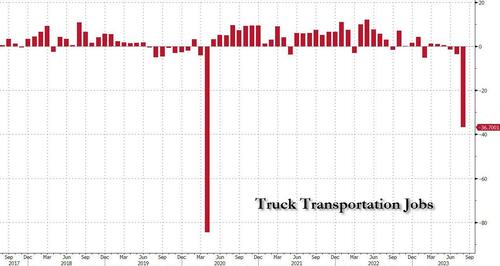Yellow Fever: Truck Transportation Jobs Plummet In August
By John Kingston of FreightWaves
Truck transportation jobs plummeted in August, according to the Bureau of Labor Statistics, with the likelihood that the demise of Yellow Corp. was largely responsible for sending the employment total down by 36,700 employees.
To put that drop in perspective, in the past 10 years the only month with a larger decline was April 2020, when the economy took the full blow from the start of the pandemic. Truck transportation jobs on a seasonal basis that month dropped 84,500 jobs from March.
Since then, there have only been six months in which truck transportation jobs declined, four of them this year. And those job losses totaled just 16,900 jobs, less than half of those lost in August alone.
The only other month with higher job loss than August was due to a Teamsters strike in April 1994.
“Following Yellow’s bankruptcy on July 31, much of this loss is attributed to LTL trucking,” Breakthrough Fuel Chief Economist Matt Muenster said in an email to FreightWaves.
The 1,567,700 truck transportation seasonally adjusted jobs total is the lowest total since April 2022, when the BLS reported 1,571,700 jobs. Since the peak number in January, 1,611,400 jobs, the total number of truck transportation jobs reported by the BLS is down by 43,800 jobs.
The BLS breaks out data by truckload and LTL with a time lag of a month, so there is no way of knowing for certain that the decline in employment was heavily weighted toward LTL, as would be expected if the decline was driven by the shuttering of Yellow.
Ironically, even as truck transportation jobs were plummeting, warehouse jobs stabilized for the first time in months.
Warehouse jobs had declined for seven consecutive months and 10 of the past 11; in the one month in that stretch when jobs didn’t decline, job totals were flat.
The August increase of 600 jobs was the first rise in that number since June of last year. But with a downward revision of the total for June of this year, even the small gain in August could not push the warehouse jobs total above 1.9 million. Jobs in the warehouse sector had not been less than 1.9 million since January 2022, just before the annual revision of the BLS model produced a giant increase in the warehouse jobs estimate.
Another area that took a big hit was couriers. August jobs totaled 1,100,300, down 9,000 jobs from 1,109,300. And that was on top of a revision in the July number which sent that figure down by 8,100 jobs. Throw in a revision in the June numbers and courier jobs stood at 13,900 fewer in August than they were two months earlier.
As Muenster noted, even with the latest decline, total truck transportation employment is down just 2.1% year on year “and remains elevated from 2021 and pre-pandemic levels.”
In August 2019, jobs in truck transportation were 1,529,400.
Muenster, in reviewing the one-month lag figures that break out employment by sector, said the data on long distance truckload, both in number of jobs and hours worked, “stand out because they continue to show the sector is more resilient to the weak freight market than other trucking sectors.”
David Spencer, the vice president of market intelligence at Arrive Logistics, saw a bright spot. “As tough as it is to see, capacity leaving the market can be a good thing for those who can survive the current environment,” he said in an email to FreightWaves. “Ultimately, this trend is what will set up market vulnerability, enabling the next inflationary cycle. I’m still predicting this to occur in the later part of the first half of 2024,, by Q2.”
In other highlights from the report:
- Not seasonally adjusted jobs in truck transportation, which can often diverge from the seasonal numbers, did not stray far this time around. The job decline in that category was 35,700, just 1,000 jobs fewer than the seasonal report.
- Rail employment had held steady between 144,000 and 147,000 jobs for several years. Its increase to more than 150,000 jobs in the past year was seen as significant because as an industry, railroads had been been taking incoming pressure and criticism that they had let too many workers go. It now appears to be at a new normal: Rail jobs in August totaled 150,200, identical to June, and July jobs in between came in at 150,400.
Tyler Durden
Fri, 09/01/2023 – 15:05
via ZeroHedge News https://ift.tt/HgRzbY4 Tyler Durden

